Companies that excel in performance management gain a competitive edge. They also see higher employee engagement, better retention, and a stronger company culture. That’s why performance management should never be ignored.
An effective employee performance management system helps employees understand their roles. It provides regular feedback and ensures employees get the guidance needed to achieve goals.
This guide outlines what a performance management system is and offers practical strategies, tools, and tips to enhance your approach. Whether you're just starting or looking to improve your existing system, you'll find valuable advice to achieve better results.
What is a performance management system?
A performance management system (PMS) helps organizations track, evaluate, and improve employee performance.
It connects individual achievements to business goals. This ensures employees contribute to the company’s success. Regular evaluations, clear goal-setting, and ongoing feedback create a cycle of continuous improvement.
Key stages of the performance management process
A typical performance management cycle has four stages.

Planning
Set clear performance expectations by aligning goals with job roles. Work with employees to create SMART goals and define performance metrics.
Monitoring
Regularly track performance and provide continuous feedback to address issues promptly.
Developing
Analyze performance data to identify gaps. Offer training, coaching, or extra projects to promote employee growth.
Rating & rewarding
Evaluate performance and provide rewards. For example, you can conduct formal reviews, 360-degree feedback, and reward high performers.
Why is a performance management system important?
A performance management system benefits everyone. It sets clear expectations, offers continuous feedback, and links performance to company goals. This boosts engagement, accountability, and growth.
Benefits of a performance management system
For organizations
Improved productivity & efficiency: Employees stay focused and contribute more when goals are clear and performance is tracked.
Goal alignment: Ensures individual and team objectives support broader business strategies. This helps create a results-driven culture.
For employees
Higher engagement & motivation: Regular feedback and recognition foster a positive work environment. This makes employees feel valued.
Career growth & development: Performance metrics and development plans help employees advance their careers.
For HR professionals
Streamlined processes: Automated evaluations and goal tracking reduce administrative workload. This allows HR teams to focus on strategic initiatives.
Data-driven insights: Performance management tools help HR leaders identify trends, address challenges, and make informed workforce decisions.
Performance management statistics
Organizations with continuous performance processes are 39% better at attracting top talent. They are also 44% better at retaining talent. (Betterworks, 2020)
Four out of 10 workers are actively disengaged when they get little to no feedback. (Clear Company, 2020)
93% of organizations conduct employee performance reviews, with 71% conducting annual performance reviews. (SHRM, 2018)
Regular feedback makes employees nearly three times more likely to be engaged. (Gallup, 2019)
Only 44% of employees are satisfied with performance management in their organization. (RedThread Research, 2024)
A strategic performance management system does more than measure performance—it enhances it. It also fosters a workplace where employees thrive and businesses excel.
Types of performance management systems
Different types of performance management systems cater to various organizational needs and goals. Below are four common types of PMS:
Traditional performance management systems
Traditional performance management processes rely on structured, periodic evaluations based on predefined metrics. These systems focus on assessing past performance and aligning employees with organizational goals. However, they can lack flexibility in dynamic work environments.
Annual reviews & top-down evaluations
Employees undergo performance assessments once or twice a year based on predetermined criteria.
Managers unilaterally evaluate employees without extensive peer or self-assessment input.
Challenges: Infrequent feedback delays performance corrections and subjective evaluations can introduce bias.
Management by Objectives (MBO)
Managers and employees collaboratively define objectives that align with company goals.
Objectives are typically reviewed on a semi-annual or annual basis. This makes them more rigid and less adaptable to sudden changes.
Example: A sales associate sets an objective to increase monthly sales by 15%. Formal check-ins are scheduled at the six-month and annual mark to review progress.
Limitations: Lacks the flexibility needed for rapidly changing industries. This is because objectives are set for extended periods.
Key performance indicators (KPIs)
Quantifiable metrics assess individual, departmental, and organizational success.
In traditional performance management systems, KPIs are reviewed in periodic evaluations. In modern systems, they are continuously monitored for real-time adjustments.
Example: A customer service representative is assessed on metrics such as average response time and customer satisfaction scores.
Agile performance management systems
Agile performance management systems prioritize flexibility, real-time feedback, and continuous improvement. These systems are ideal for dynamic and fast-paced organizations.
Objectives and key results (OKRs)
A goal-setting framework that emphasizes ambitious objectives and measurable key results.
Unlike MBO, OKRs are typically set on a quarterly basis. This allows for frequent course correction and alignment with business priorities.
Example:
Objective: Improve customer satisfaction.
Key Result 1: Resolve 95% of customer complaints within 24 hours.
Key Result 2: Complete the customer satisfaction course in Q2.
OKRs foster a culture of continuous improvement and encourage stretch goals. They also more readily evolve business needs.
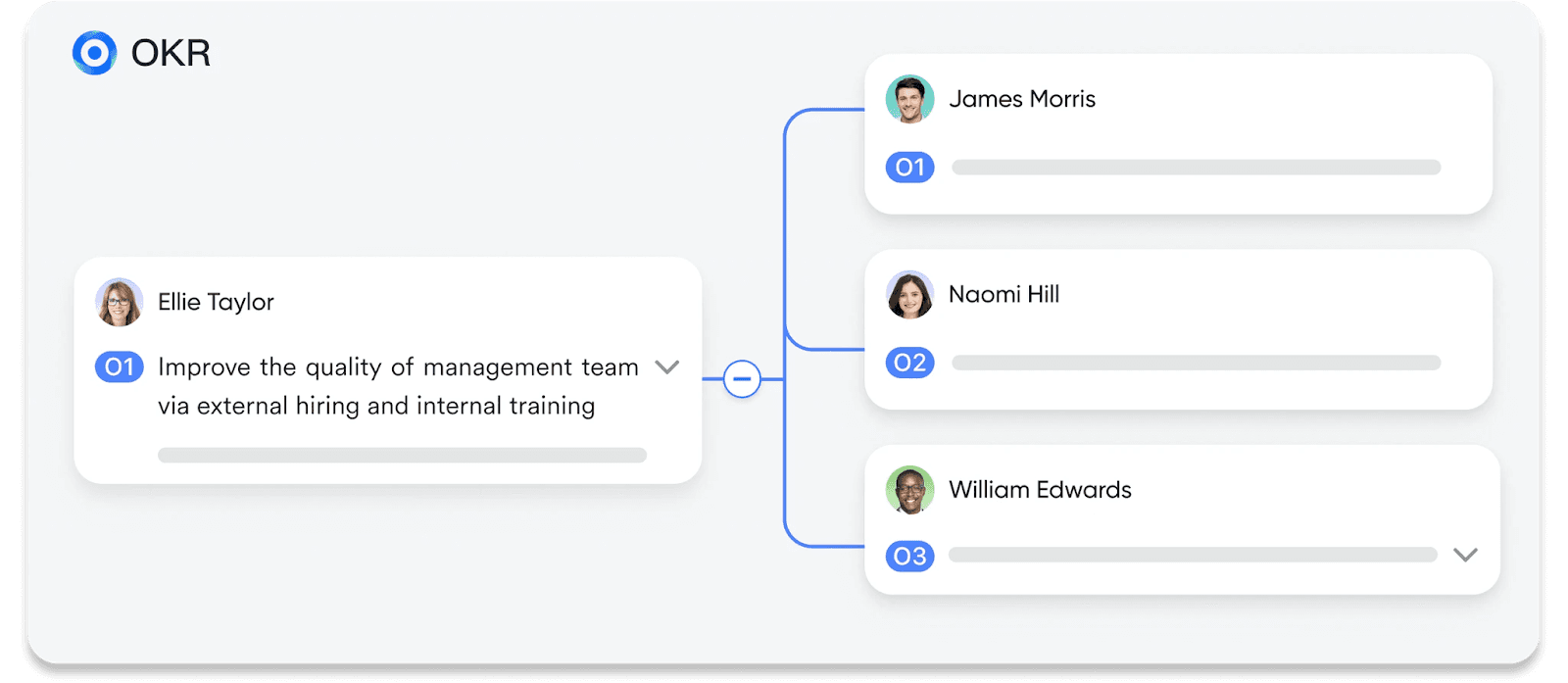
Frequent feedback & check-ins
Regular one-on-one meetings between employees and managers replace annual reviews.
Employees actively participate in setting their goals and tracking progress.
Example: A software developer receives monthly feedback on coding efficiency and project contributions. This ensures alignment with evolving team objectives.
360-degree feedback systems
These systems offer a complete view of an employee’s performance. This is done by gathering feedback from various sources.
360-degree feedback
Employees receive feedback from managers, peers, subordinates, and self-assessments. This helps management get a better idea of an employee's performance.
Example: Team members evaluate a project manager's leadership skills after working on a project.
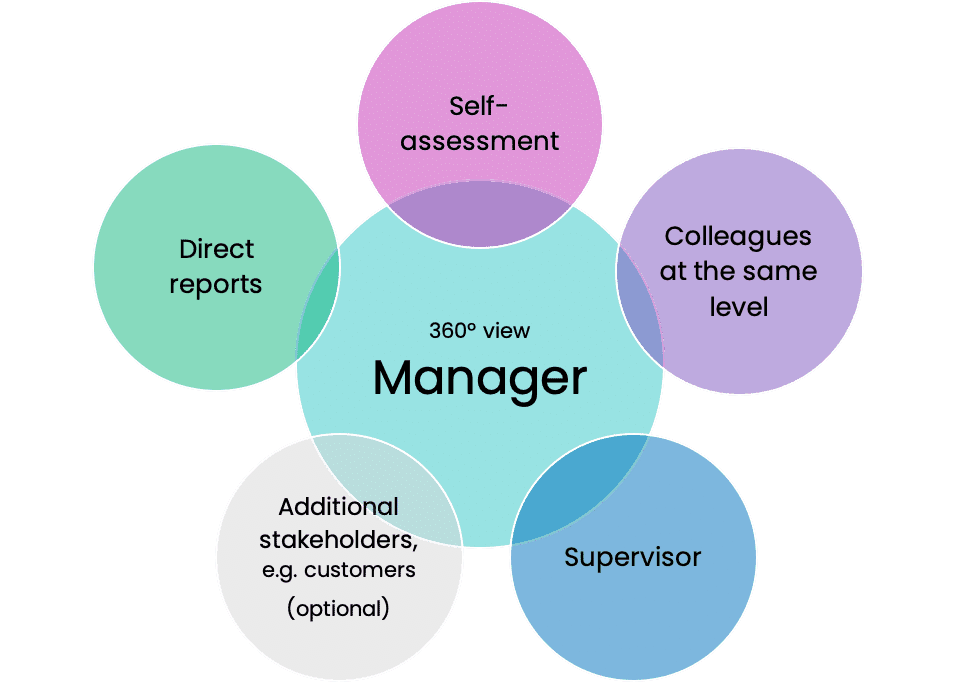
Source: netigate.net
Technology-driven performance management systems
Modern performance management systems use software to improve performance tracking, feedback, and decision-making.
Automated performance tracking
Performance management software automates review cycles, feedback collection, and progress tracking. This ensures efficiency and consistency.
Example: An HR team uses performance management software to send automated reminders for performance reviews. The software also compiles real-time performance data to help HR staff make decisions.
AI & predictive analytics
AI-driven insights analyze performance trends and recommend targeted development strategies.
Example: A company uses AI to identify disengaged employees and suggests personalized training programs to boost productivity.
Real-life examples of performance management systems
The performance management system a company adopts depends on various factors. This includes the organization's size, structure, culture, and company objectives.
Companies tend to blend different methods. For example, a company may use annual reviews, continuous feedback, and KPIs. Below are examples of how businesses apply performance management in their workforce:
Netflix, the popular streaming service, employs a 360-degree feedback method. This allows Netflix to assess its employees' performance from many perspectives. (Business Insider, 2020)
Panasonic, a global industrial conglomerate, uses OKRs to promote goal-setting. This is to help employees stay focused on achieving their targets. (Indeed, 2024)
Google, the search engine giant, uses self-assessment, 360-degree feedback, and monthly check-ins. (PerformYard, 2024)
ByteDance, the creator of TikTok, uses OKRs and 360-degree feedback. This lets employees align goals and helps managers assess performances from different perspectives. (Harvard Business Review, 2022)
Common challenges in implementing performance management systems
A well-structured performance management system can improve organizational success. However, implementation isn’t always seamless. Addressing common issues early ensures a smoother transition and maximizes effectiveness.
Bias in evaluations
Unconscious bias can lead to unfair assessments, reducing trust and employee morale.
Use standardized criteria: Define performance metrics and structured rating scales to maintain consistency.
Train managers on bias awareness: Provide training on how to recognize and mitigate bias.
Lack of transparency
Employees will feel frustrated if you don't explain how you evaluate performance. They will also feel disheartened if you don't explain how you make decisions.
Foster open communication: Outline the evaluation process and performance expectations. This will remove uncertainty.
Encourage access to feedback: Allow employees to review their feedback and discuss it with their managers.
Resistance to change
New performance management systems can be overwhelming for employees and managers. This can lead to resistance.
Involve your employees early: Engage staff in the process from the start, gathering input to increase buy-in.
Install gradually: Roll out the performance management system in phases. Also, provide ongoing support to ease the transition.
Best practices for implementing a performance management system
Follow best practices to enjoy the benefits of a performance management system.
Regular feedback and communication
Replace annual reviews with frequent check-ins. This helps address challenges early, align goals, and improve engagement.
Clear and SMART goals
Set SMART goals when using performance management tools. These Specific, Measurable, Achievable, Relevant, and Time-bound goals provide clearer direction to employees.
Fair and inclusive processes
A key aspect of implementing a performance management system in HRM is ensuring that evaluations remain unbiased and transparent.
HR teams and managers should establish consistent performance metrics. Also, they should involve employees in feedback discussions.
Employee development focus
Go beyond evaluating employees. Incorporate training, coaching, and mentoring. This will help your workforce build skills and confidence, and increase productivity.
Leveraging technology
Use performance management software to streamline feedback, track progress, and generate actionable insights.
Customization
Tailor your performance management system to reflect your company’s culture, values, and goals.
Use performance management templates
Free ready-made templates can help you implement your employee performance management system. Use templates for goal-setting, feedback collection, and performance reviews to simplify your work.
Try this free employee performance review template to get started giving structured evaluations.
Emerging trends in performance management systems
Performance management is continuously evolving. This is driven by advancements in technology and shifts in workplace priorities. Here are the top trends shaping the future of PMS:
AI and automation
Artificial Intelligence (AI) is revolutionizing performance management. It can now offer predictive analytics, real-time feedback, and automated evaluations. AI-powered tools can identify trends, flag potential issues, and reduce human bias.
Cloud-based, real-time solutions
Cloud-based performance management software is gaining popularity for its real-time feedback capabilities. This software lets employees and managers track and update performance from anywhere. This promotes flexibility and collaboration in remote or hybrid work environments.
Focus on employee well-being
Modern performance management prioritizes employee well-being, recognizing its impact on performance. Modern performance management strategies now include well-being initiatves. These include mental health support, wellness programs, and more.
Agile performance management
Rigid, traditional performance management systems are being replaced by agile models. Agile systems emphasize frequent feedback, goal-setting flexibility, and adaptability to changing business needs. This approach helps organizations stay responsive and competitive in fast-paced environments.
How to implement a performance management system
Implementing a performance management system can drive success when done strategically. Here's a step-by-step guide to help you implement it effectively:
Step 1: Assess your organization's needs
Begin by reviewing your current performance management practices to identify areas for improvement.
Evaluate existing processes: Are performance reviews clear? Do they align with company goals? Are employees getting the feedback they need?
Identify gaps: Look for missing elements like unclear goals or infrequent evaluations.
Employee feedback: Gather insights from employees about the current system. Do they feel engaged and supported?
Step 2: Choose the right system and software
Select a performance management system that suits your company's size, culture, and goals. In addition, select a performance management software that can implement your system.
Key features: Look for goal-setting tools, performance tracking, and feedback features that meet your needs.
Automation: Consider systems with automated reminders and reviews to save time and improve consistency.
Integration: Choose a system that works well with your existing HR tools for smoother workflows.
Scalability: Pick a PMS that can grow with your business as it expands or shifts to remote work.
User-friendly: Ensure the system is easy for both managers and employees to use.
Step 3: Train managers and employees
Effective training is essential for performance management success.
Train managers: Ensure they understand how to give constructive feedback, set goals, and use the system and software.
Train employees: Help them understand how to track progress and engage with feedback.
Ongoing support: Provide resources such as guides or tutorials. This will help managers and employees understand the evaluation process.
Step 4: Monitor and adjust
A performance management system should evolve with your company's needs.
Track usage: Check if managers and employees are using the system properly.
Evaluate effectiveness: Assess whether employees are achieving goals and feel motivated.
Collect feedback: Regularly ask for feedback on the system to identify challenges.
Make adjustments: Use the feedback to optimize your system for better results. This can include refining goal-setting or adding new performance metrics.
Continuous improvement: Update your processes as trends such as AI continue to emerge. This will ensure your organization doesn't fall behind.
How Lark enhances performance management
Managing employee performance can be challenging. Traditional methods often struggle with key areas like setting clear goals and giving timely feedback.
Lark addresses these issues with its all-in-one app. It combines performance management, collaboration, and project management all in one platform.
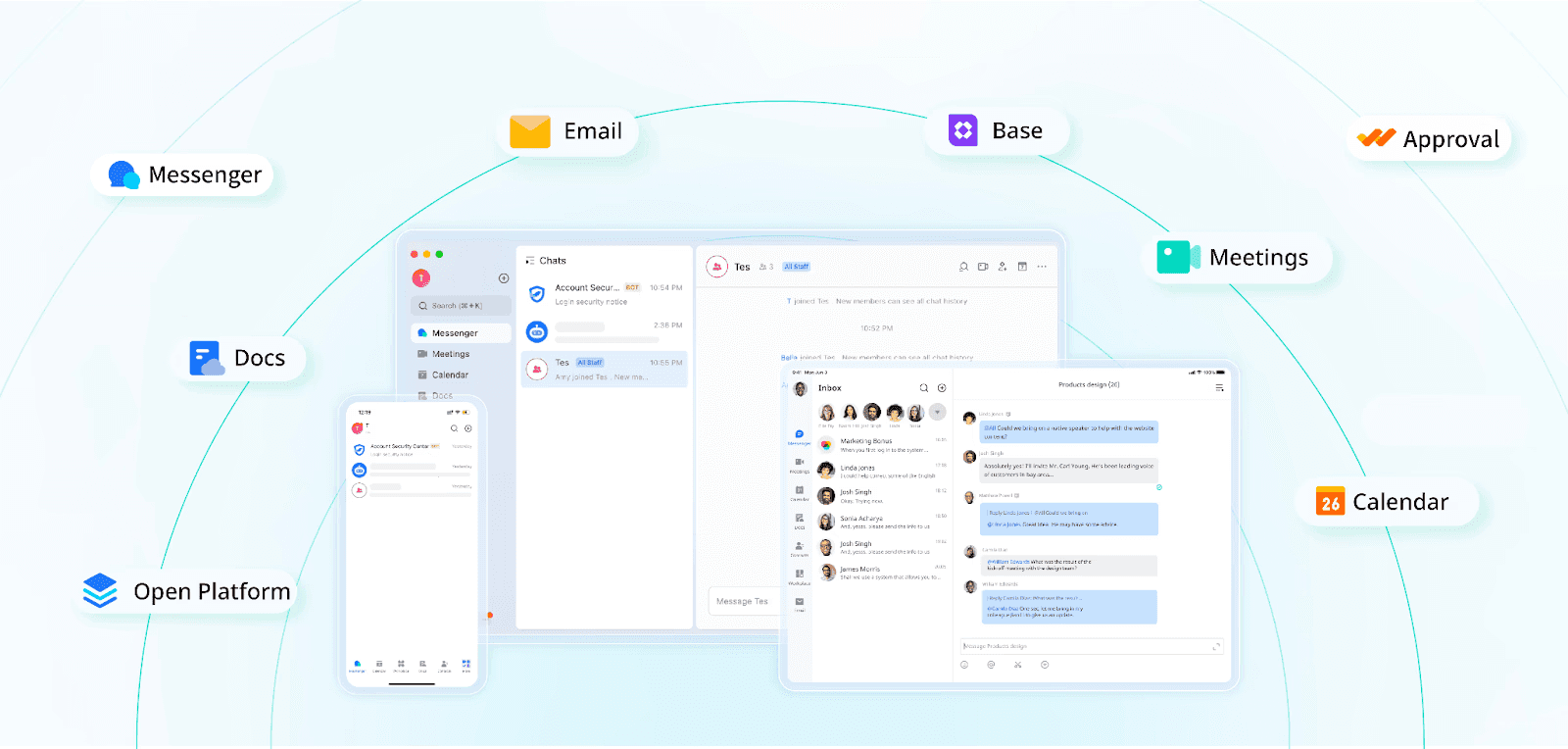
Pain Point 1: Difficulty in goal setting and alignment
Many employees struggle to see how their goals align with the company's objectives. This confuses and disconnects members and can negatively impact results.
How Lark helps:
Lark’s strategic performance management system makes it easy to set and track goals that align with business objectives.
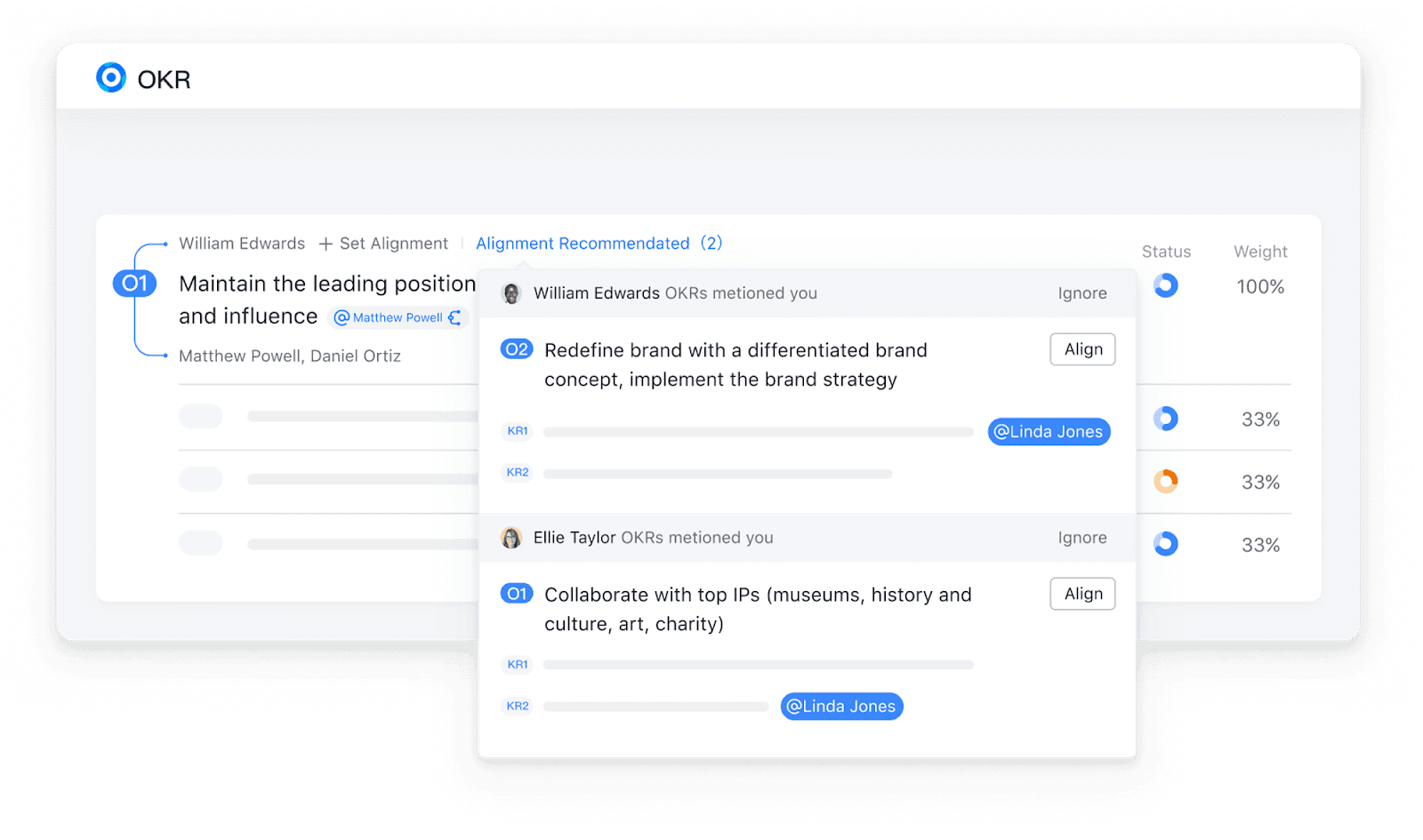
OKR management: With Lark OKR, you can set objectives at every level - from company-wide objectives to individual targets. This ensures employees always understand how their work contributes to larger goals.
Real-time progress: Objectives and key results in Lark OKR update in real time. This means everyone stays on the same page and can adjust targets as needed.
Cross-department collaboration: Lark's collaboration tools include instant messaging, document collaboration, and more. This means teams from different departments can work together on shared goals all in one app.
Pain point 2: Lack of continuous feedback and communication
Waiting for annual or quarterly performance reviews makes feedback feel like an afterthought. Employees will miss out on guidance and feel disconnected without regular communication.
How Lark helps:
Employees receive feedback in real time so they can act on advice right away.
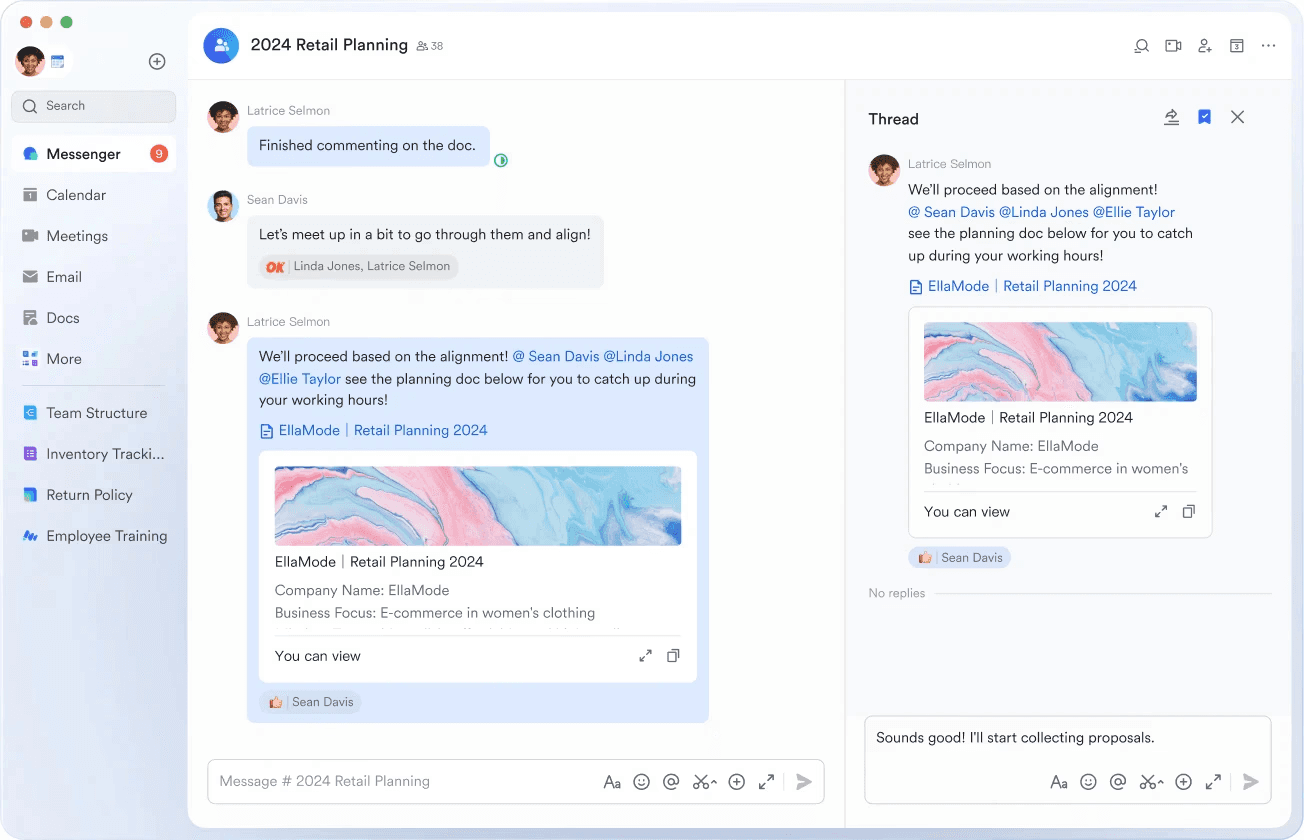
Instant messaging and video calls: Managers and employees can have quick check-ins through chats or video calls.
Frequent check-ins: You can schedule regular feedback sessions through Lark’s calendar feature.
Feedback tracking: Lark’s tools also let managers track feedback over time, so employees can see their progress and growth.
Pain point 3: Lack of data-driven evaluations
Bias and unfair decisions damage trust within your team. To avoid this, your organization should use data-driven insights to check performance.
How Lark helps:
Lark makes performance evaluations more transparent, fair, and based on actual data.
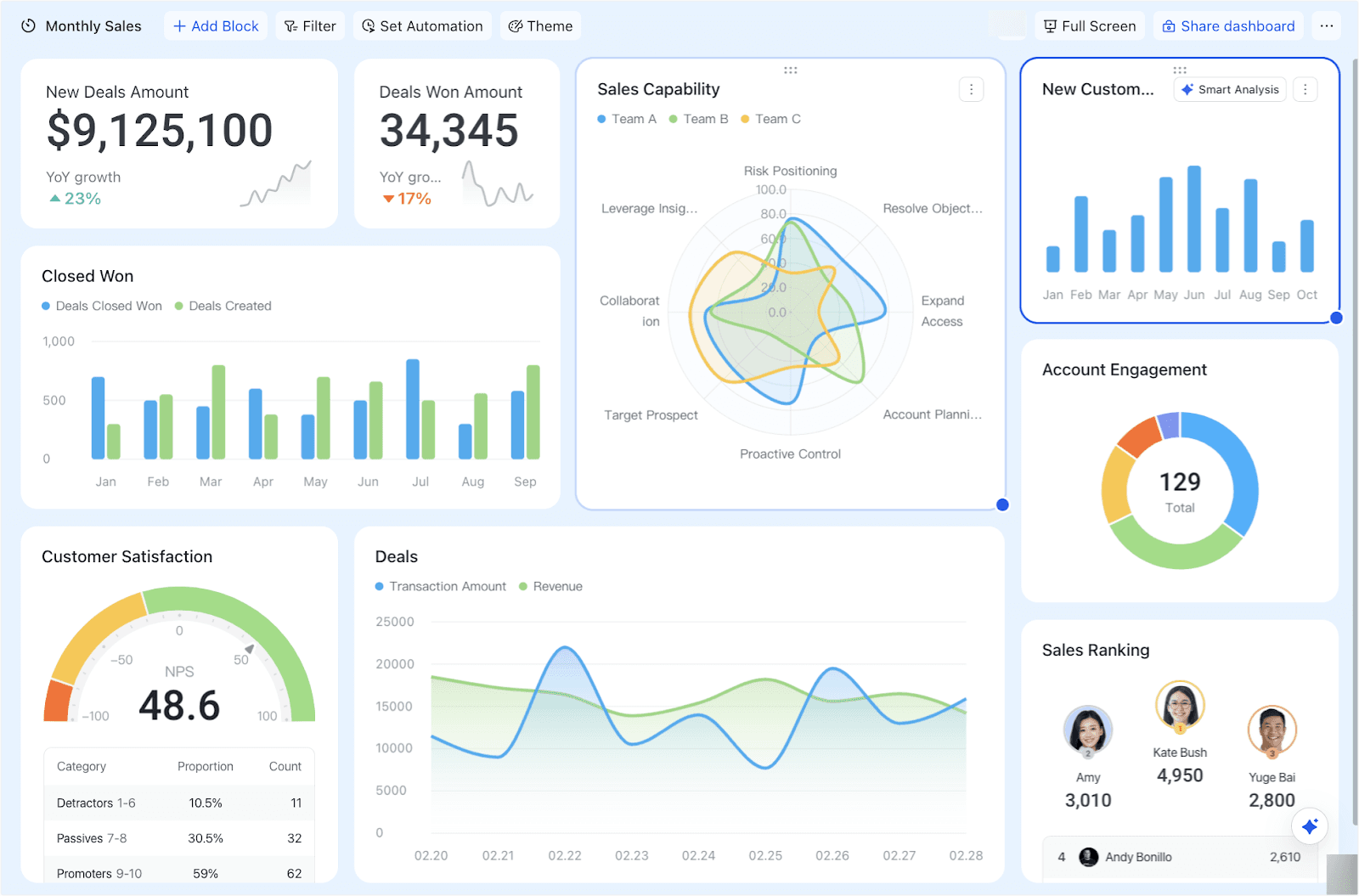
Task and project data: Lark’s task and project management features track how much work is getting done. This helps managers make performance decisions based on actual data.
Automated reports: Lark’s data analysis and dashboard tools allow managers to generate reports with key metrics, so performance evaluations are always backed by data.
360-degree feedback: Collect feedback from peers, managers, and subordinates to create a comprehensive picture of each employee’s performance. This reduces bias and promotes fairness in evaluations.
Pain point 4: Inconsistent tracking and documentation
Managers struggle to document progress or maintain consistent evaluations without a structured system. This can lead to unclear expectations, missed development opportunities, and ineffective performance reviews.
How Lark helps:
You can use Lark's free performance management templates to track and document performance.
For example, you can use this free KPI template if your organization wants to set KPIs for its workforce.
Final thoughts on performance management systems
A performance management system is more than just a tool. It’s the foundation for growth, engagement, and long-term success. With goal-setting, continuous feedback, and employee development, businesses can create a high-performance culture where both individuals and teams thrive.
Lark gives you the flexibility to build a system that fits your team’s needs. Set clear goals, track progress in real time, and make data-driven decisions—all in one place. As technology evolves, Lark keeps your performance management strategy simple, effective, and future-ready.
Table of Contents









